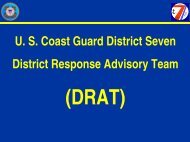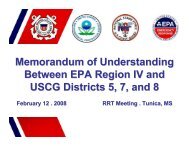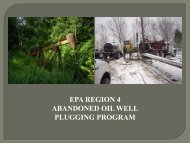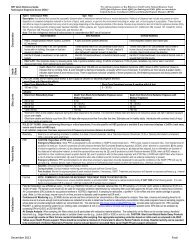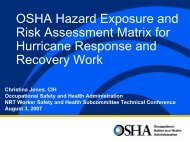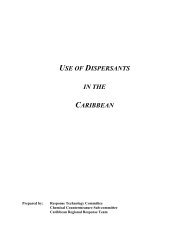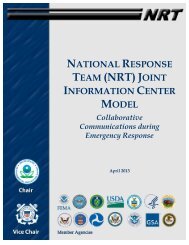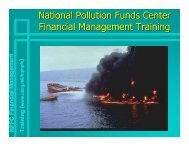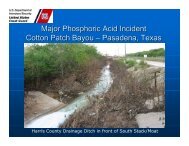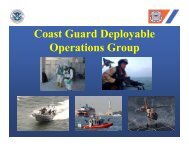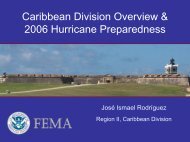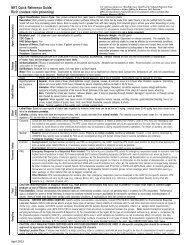U.S. Department of Justice - U.S. National Response Team (NRT)
U.S. Department of Justice - U.S. National Response Team (NRT)
U.S. Department of Justice - U.S. National Response Team (NRT)
- No tags were found...
You also want an ePaper? Increase the reach of your titles
YUMPU automatically turns print PDFs into web optimized ePapers that Google loves.
U.S. <strong>Department</strong> <strong>of</strong> <strong>Justice</strong>POINTS OF CONTACT:PrimaryMr. Bob Brook – Environmental and Natural Resources DivisionPhone: (202) 514-2738Fax: (202) 616-658324 Hour:Email:bob.brook@usdoj.gov2 nd PrimaryMs. Debra J. Kossow – Senior Admiralty CounselPhone: (202) 616-4070Fax: (202) 616-400224 Hour:Email: debra.kossow@usdoj.govAlternativeMr. Bruce Gelber – Environmental and Natural Resources DivisionPhone: (202) 514-4624Fax: (202) 514-009724 Hour:Email:bruce.gelbar@usdoj.govGENERALThe U.S. <strong>Department</strong> <strong>of</strong> <strong>Justice</strong> (DOJ) can provide expert advice oncomplicated legal questions arising from discharges or releases, andFederal agency responses. In addition, the DOJ represents theFederal government, including its agencies, in litigation relating tosuch discharges or releases. Other legal issues or questions shall bedirected to the Federal agency counsel for the agency providing theOSC for the response.DOJ’s Environment and Natural Resources Division, which isorganized into ten sections, has primary responsibility for litigationon behalf <strong>of</strong> the United States regarding prevention and clean up <strong>of</strong>pollution, environmental challenges to Federal programs andactivities, stewardship <strong>of</strong> public lands and natural resources,acquisition <strong>of</strong> property for Federal needs, wildlife protection, andIndian rights and claims. With <strong>of</strong>fices across the United States, theDivision is the nation’s environmental lawyer, and the largestenvironmental law firm in the country.Mission and GoalsDOJ’s Environmental and Natural Resources Division providesexpert advice on complex legal issues involving:Pollution and Cleanup <strong>of</strong> Pollution: One <strong>of</strong> the Division’sprimary goals is to enforce Federal civil and criminalenvironmental laws such as:• The Clean Air Act to reduce air pollution• The Clean Water Act to reduce water pollution andprotect wetlands• The Resource Conservation and Recovery Act(RCRA) to ensure hazardous wastes are properlystored, transported, and disposed• the Comprehensive Environmental <strong>Response</strong>,Compensation and Liability Act (CERCLA)• the Safe Water Drinking Act and Lead HazardReduction ActChallenges to Federal programs and agencies: TheDivision’s cases frequently involve allegations that a Federalprogram or action violates Constitutional provisions orenvironmental statutes.Property Acquisition for Federal Needs: Another significantportion <strong>of</strong> the Division's caseload consists <strong>of</strong> non-discretionaryeminent domain litigation. This important work, undertakenwith Congressional direction or authority, involves theacquisition <strong>of</strong> land for important national projects such as<strong>National</strong> Parks, the construction <strong>of</strong> federal buildings, and fornational security related purposes.Organization/StructureThe Environment and Natural Resources Division is organizedinto ten sections, including:• Environmental Crimes Section• Environmental Defense Section• Natural Resources Section• Wildlife and Marine Section• Indian Resources Section• Land Acquisition Section• Law and Policy Section• Appelate Section• Executive Office
U.S. <strong>Department</strong> <strong>of</strong> <strong>Justice</strong> Fact SheetPage 2 <strong>of</strong> 2Role/ResponsibilityDuring a response, under the NCP for oil and hazardous materials,under the Stafford Act for presidentially declared disasters oremergency, or under the <strong>National</strong> <strong>Response</strong> Framework, DOJ playsa significant role in the federal response. Their primary strategicrole <strong>of</strong> DOJ is to provide expert legal advice, particularly regardingpotential criminal cases. The Attorney General has leadresponsibility for criminal investigations <strong>of</strong> terrorist acts, wheresuch acts are within the Federal jurisdiction <strong>of</strong> the United States.The Attorney General, through cooperation with other Federaldepartments and agencies, also coordinates the activities <strong>of</strong> othermembers <strong>of</strong> the law enforcement community to detect, prevent,preempt, and disrupt terrorist attacks against the United States.Laws/Authorities Governing their<strong>Response</strong> (to be reviewed)• The <strong>National</strong> Oil and Hazardous Substances PollutionContingency Plan (NCP)• The Oil Pollution Act <strong>of</strong> 1990• <strong>National</strong> <strong>Response</strong> Framework (NRF)• The Comprehensive Environmental <strong>Response</strong>,Compensation, and Liability Act,• Executive Order 12148 — Federal EmergencyManagement• Executive Order 12656 — Assignment Of EmergencyPreparedness Responsibilities• Executive Order 12777 - Outlines the responsibilities<strong>of</strong> certain Federal agencies in preventing andcontaining discharges <strong>of</strong> oil and hazardous substances• The Robert T. Stafford Disaster Relief andEmergency Assistance Act• The Post-Katrina Emergency Management ReformAct• Flood Control and Coastal Emergencies Act• The Defense Production Act <strong>of</strong> 1950 as Amended• The <strong>National</strong> Emergencies Act• HSPD-5 - Management <strong>of</strong> Domestic Incidents• HSPD-7 - Critical Infrastructure• HSPD-8 - <strong>National</strong> Preparedness• HSPD-9 - Defense <strong>of</strong> United States Agriculture andFoodagencies (Support Agencies) to provide resources for eachfunctional area. The mission <strong>of</strong> the ESFs is to provide the greatestpossible access to capabilities <strong>of</strong> the Federal Governmentregardless <strong>of</strong> which agency has those capabilities. Under the<strong>National</strong> <strong>Response</strong> Framework (formerly known as the <strong>National</strong><strong>Response</strong> Plan), the DOJ and its member divisions and servicesplay a role (either as the Primary or as a Support agency) for thefollowing ESFs:ESF #PrimaryAgencySupportAgency1 Transportation X2 Communications3 Public Works & Engineering4 Firefighting5 Emergency Management X6 Mass Care, EmergencyAssistance, Housing, andHuman Services7 Logistics Management andResource Support8 Public Health and MedicalServices9 Search and Rescue X10 Oil and Hazardous Materials<strong>Response</strong>11 Agriculture and NaturalResources12 Energy13 Public Safety and Security X14 Long-Term CommunityRecovery15 External Affairs XXXXX<strong>Response</strong> RequirementsDuring times <strong>of</strong> national threat or a Presidential Declaration, the<strong>Department</strong> <strong>of</strong> Homeland Security serves as the planning integratorfor the President for a more robust federal incident managementcapability and in order to coordinate all Federal incidentManagement Activities in support <strong>of</strong> our State and local partners.All Federal departments and agencies may play significant roles inincident management and response activities, depending on thenature and size <strong>of</strong> an event. The Federal Emergency ManagementAgency (FEMA) coordinates response support from across theFederal Government and certain non-governmental organizations(NGOs) by calling up, as needed, one or more <strong>of</strong> the 15Emergency Support Functions (ESFs).Each <strong>of</strong> these functions are coordinated by a single agency(Primary ESF Coordinating Agency) but may rely on other



